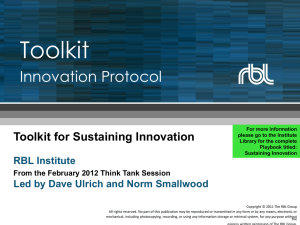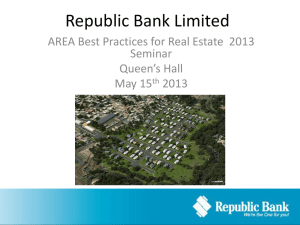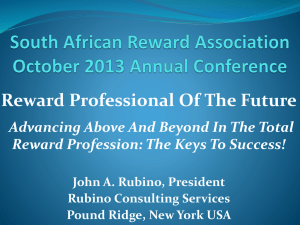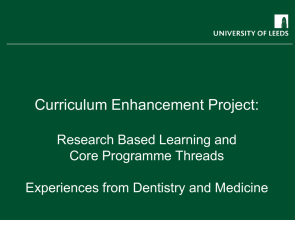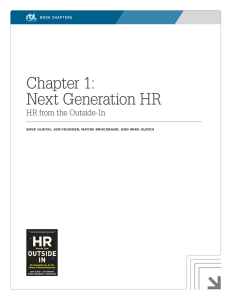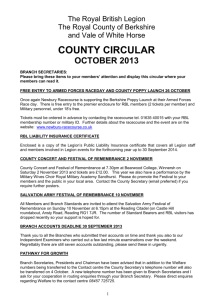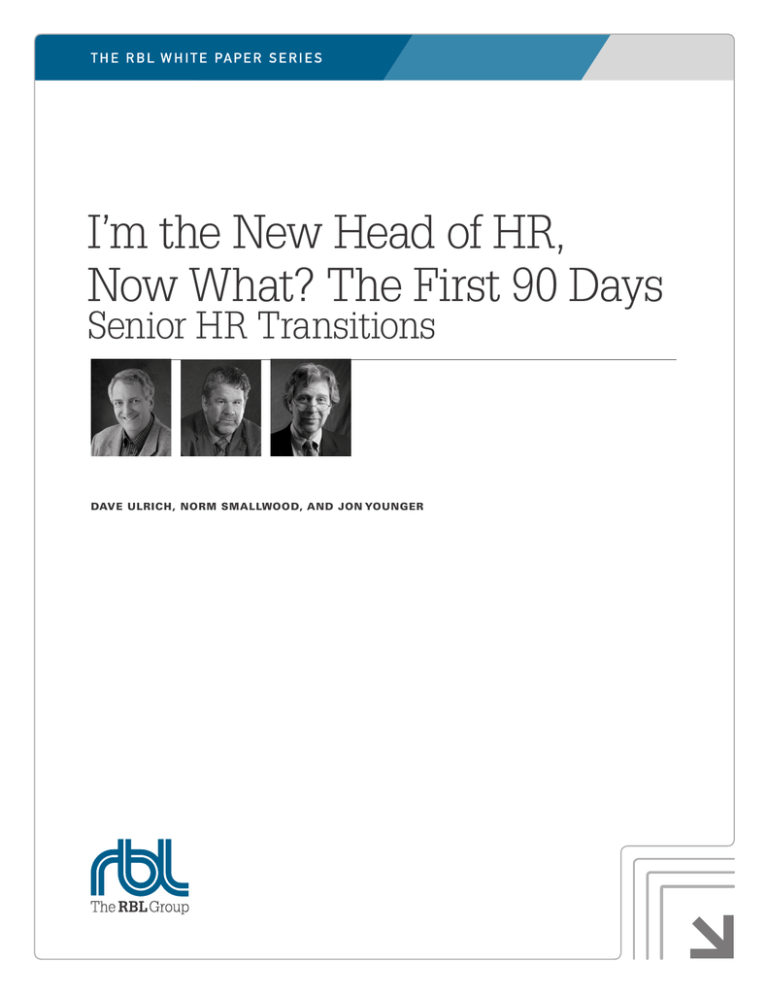
The RBL White Paper Series
I’m the New Head of HR,
Now What? The First 90 Days
Senior HR Transitions
DAVE ULRICH, NORM SMALLWOOD, AND JON YOUNGER
I’m the New Head of HR, Now What?
The First 90 Days (Senior HR Transitions)
Dave Ulrich and Norm Smallwood
S
o, you just got the top HR job. Congratulations!
understand their perspectives. These 30- to 60-minute meet-
Your business leader has said the right things. He
ings not only inform you about how the business operates,
wants a partner who will contribute to business
but informs them about what insights you might offer. By
success. He needs someone who will help build talent and
the questions you ask, you set a contract for how you deliver
organization for the future. He wants to deliver on aggressive
value to them.
financial and customer goals with a bold strategy that he
i. Talk to senior line managers about the business, their
knows will be difficult to execute. He is open to your ideas.
goals, their experiences with HR, and about how people
Now that the dog has caught the car, what questions
and organization can help them deliver their goals.
and actions should drive your first 90 days?
ii. Talk to CFO’s about the financial requirements for success. Find out about the market value of the firm, particu-
1. DO I REALLY KNOW THE BUSINESS?
Business knowledge requires the basics of mastering the
income statement and balance sheet, reviewing the business
strategy, and understanding industry dynamics. The MBA
basics allow you to then deep dive into the specifics of how
the business works.
a. Do I know how we make money?
Each business has a unique formula for making money. You
need to learn who customers are and why they pay your firm
for products or services. You may want to do a process map
of creating products/services through customer payment for
those products through disbursement of that cash. This cash
flow map helps you recognize how your company makes
money and provides value to your customers. This cash flow
map may come from discussions with finance and marketing colleagues. They may be surprised that your conversation with them focuses on cash more than people, but it is
imperative to learn the business. You may also look at recent
presentations given at the Board of Directors or other senior
management meetings where industry and firm overviews
are regularly scheduled. Getting acquainted with the person
or people who prepare these presentations (often in strategy
roles) is a good source of business insight.
b. Do I see how the business operates
from multiple points of view?
Different stakeholders have different views of what business is about. In the first three months, you have the luxury
of asking the naïve but interested questions that help you
I’m the New Head of HR, Now What? | © The RBL Group
larly intangibles, and how investors perceive the firm’s
current intangible value. Learn the financial metrics that
matter most in this company and ask them to help put HR
investments in these terms.
iii. Talk to customers about how your organization does
relative to competitors. What are their buying criteria?
What do they want more or less of from your firm? What
is your firm’s current and desired reputation (or brand)?
How could they participate in designing innovative HR
practices to deliver on the brand they desire?
iv. Talk to analysts and investors who value your firm in the
public marketplace (or headquarters if you are in a region
or business). Find out what they look for in valuing your
firm, how your firm ranks with competitors on intangibles,
and what would have to happen to increase their confidence in you.
Some of these early meetings may surprise people. These
meetings are not designed to learn about what to teach
on Day 3 of your one-week leadership program; they are
designed to help you build relationship equity with key
stakeholders. They are also meant to help you learn the business from a business point of view.
c. Do I have first-hand experience
with the product/service?
Sometimes, when new to a company we don’t know the
products or services. It i s useful to act like a customer or user
and see how the product/service works. Buy the product, use
the service, choose among competitor products or services.
See your organization through the eyes of the customer.
1
d. Do I have relationships with key people?
Get to know the people you will be working with. Find out
about their goals and objectives so that you can work with
them. Spend some private time with key colleagues. In these
informal discussions find out answers to some of the questions:
i. Why did I get the job? What are the strengths I bring that
3. DO I HAVE A SENSE OF THE KEY HR PRIORITIES?
An easy and common mistake is trying to be all things to all
people. In study after study, leaders need to synthesize and
prioritize. In your first few observations of your company
you will probably find many things that could be improved.
List them. Think about them. Prioritize them. If you have 10
you want me to deliver?
projects and 100 units of resources, the wrong allocation is 10
ii. What are some of the unique strengths and weaknesses
units per project. You need to focus your time and HR invest-
of the organization that I should know about?
ments on those initiatives that will be both implementable
iii. What are the land mines that I should be aware of to
(doable within time and budget) and have impact (make a
avoid?
visible difference in business results).
iv. What executive style works and what does not work here?
a. Are there some early wins?
Let others be your mentors and coaches as you try to find your
Are there some obvious areas where you can improve? Some-
way around the organization. In these conversations, also
times people who live in a house don’t see the dirt or clutter
share your views of what you think of HR. Be aware that their
that they created. With a fresh eye, you can see the clutter and
expectations of you may not be consistent with your expecta-
probably figure out what to work on first to make a difference.
tions because they have not seen what you offer.
Be willing to find the early wins and do them, fast.
e. Do I make the business the focus of my formal pre-
b. What will be the two to four HR priorities that I can
sentations and information discussions?
commit to delivering?
Talk about the business. In your meetings with HR profession-
HR strategy is built around the outcomes of doing good HR
als, begin with business updates. Send the message that you
work. These outcomes are the capabilities a company needs
are concerned about the business…use financial, customer,
to deliver on its strategy. As you move into your role, be con-
and strategic information to kick off your HR presentations.
stantly doing organization diagnoses to figure out which capabilities (talent, speed, leadership, innovation, service, efficiency,
2. DO I HAVE A BROAD MAP OF
collaboration, learning, accountability, culture) your organiza-
THE HR ACTIVITIES BEING DONE?
tion needs to deliver on strategies. Focus on these capabili-
Every company is doing HR work. Find out what is being
done by mapping it. Summarize and synthesize the work
being done with a grid of businesses (columns) by HR activities in people, performance, communication, and work (rows).
Look at the grid to see where HR investments are innovative,
aligned, and integrated. Try to assess the overall quality of HR
work within the organization. Where are the pockets of excellence? Where are the areas of concern?
a. Can I get a quick overview of what HR work has
been done?
i. What has worked well?
ii. What has not worked well?
iii. What can I learn from a grid of HR activity vs. business?
b. What HR work is innovative and could be considered best in class?
c. What HR work is aligned with business goals and
helps drive where the business is going?
ties. Get management agreement on them. Make them the
outcomes of your HR strategy. Measure them and track them.
Build 90 day plans to deliver them.
i. Are the key priorities or capabilities signed off by the
management team?
ii. Are there metrics to track them?
iii. Will they be clearly linked to business results?
4. DO I HAVE AN HR TEAM IN PLACE?
a. Do I have my direct reports in place?
i. Are there any snipers who would have liked my job and
cannot get over it?
ii. Do I need to change anyone who is clearly not credible
and my not moving them hurts my credibility?
One of your first tests of leadership is the team you have in
place. Sometimes, business leaders watch to see if you can
make the hard calls on your team to trust you with helping them make the tough calls in their business. When one
d. How integrated is the HR work? Are the staffing,
new HR executive told his senior line leader that he needs
training, rewards, and other systems driven by com-
to change people, the line executive said, “We knew this a
mon competencies and capabilities?
long time ago and wondered if you would see if and how you
I’m the New Head of HR, Now What? | © The RBL Group
2
would act. Now, the issue is if you are really a leader for this
You may manage symbols to signal a new agenda, e.g., physi-
company by doing what has to be done.” Getting your team
cal layout of office and office assignments, timing of meetings,
in place may mean disappointing some people, identifying dis-
decision making style, etc.
contents who are not pleased with your direction or style, and
b. How am I spending my time and energy?
building a team of cohorts you can trust and work with.
b. Have I assessed the ability of HR people?
You may also need to pay particular attention to where you
focus your energy as reflected by your calendar in the first 90
i. Are they credible activists?
days. Who do you meet with? Where do you meet them? What
ii. Do they know the business?
questions do you ask of others? It is important to signal a new
iii. Do they help drive strategy, change, and culture?
beginning if warranted (e.g., missing this meeting is unaccept-
iv. Are they competent in HR practices?
able or this approach to work will not work). If you calendar
v. Do they do the basics well?
does not reflect your message, you will not communicate your
In addition, your extended HR staff will look to your for guid-
message clearly.
ance. Often HR professionals are last on the development-
c. Am I raising the bar on HR?
investment list. As you state a new direction for HR and when
You can also set new standards for the HR community by
you support that direction with actual resources and support,
talking about metrics and accountabilities and tracking things
your HR staff will learn that you are serious about your agenda.
that may be new and/or different. Stating new expectations
c. Am I investing in my HR staff ?
and then demonstrating commitment to those expectations
i. Am I clear about what I expect from the HR staff?
ii. Can I help them see where we are going and the excitement for the future?
Your investments in HR should be based on a theory or point
of view about what makes a successful HR professional. This
should be based on what knowledge, skills, and abilities
HR people need to drive business success but translated to
specific behaviors.
5. HAVE I DEMONSTRATED
MY STYLE IN THE TRANSITION?
Your personal behavior in the transition will communicate
who you are and what you value. There are a number of behaviors that become magnified under the less of transition.
a. Do I honor my predecessor, but set a new agenda?
How you treat your predecessors communicates your values
and sensitivity. Often, you are brought in to change a direc-
comes as you define new metrics and hold people accountable to those metrics.
d. Am I setting the right norms and managing symbols?
Your people will watch closely your early signals … attitude,
approach, style, timing, etc. to get a sense of how you will
manage the department. What meetings are you holding?
Who attends? How are they run? How will you govern? What
are the symbols you are creating, e.g., your office space, logos,
and other changes you make?
CONCLUSION
As a new leader, you are in a unique opportunity to shape a
new agenda for the HR department. The first 90 days often
communicates that agenda by your words and deeds. When
you go into the job with a clear understanding of the agenda
you want and how you want to go about installing it, you will
increase your chances of success.
tion, but you need to build on the past, not trash or destroy it.
Taking counsel from your predecessor (or at least listening to
him/her), finding positive things to say about his/her tenure,
and then creating your own agenda are tricky transition steps.
Building on the past and creating a new future are better messages than undoing the past and redeeming the future.
I’m the New Head of HR, Now What? | © The RBL Group
3
About the Authors
DAVE ULRICH
Dave has consulted and done research with over half of the Fortune 200. Dave was the editor of the
Human Resource Management Journal 1990 to 1999, has served on the editorial board of four other
journals, is on the Board of Directors for Herman Miller, is a Fellow in the National Academy of Human
Resources, and is cofounder of the Michigan Human Resource Partnership
NORM SMALLWOOD
Norm is a recognized authority in developing businesses and their leaders to deliver results and
increase value. His current work relates to increasing business value by building organization, strategic
HR and leadership capabilities that measurably impact market value.
JON YOUNGER
Jon’s career has been a mix of consulting, executive management, and HR leadership. Prior to joining
The RBL Group, he was Chief Learning and Talent Officer of one of the largest U.S.-based financial
services organizations, responsible for the leadership development, corporate learning, staffing, performance and talent management, and succession planning. He has also managed executive compensation and HR strategy.
I’m the New Head of HR, Now What? | © The RBL Group
4
Contact us for more information
about The RBL Group products
and services:
Phone 801.616.5600
Email
rblmail@rbl.net
Online www.rbl.net
Mail
3521 N. University Ave., Suite 100
Provo, UT 84604
Copyright © The RBL Group
All rights reserved. No part of this publication may be reproduced or transmitted in any form or by any means, electronic or
mechanical, including photocopying, recording, or using any information storage or retrieval system, for any purpose without the
express written permission of The RBL Group.
Originally published in Strategic HR Review.
I’m the New Head of HR, Now What? | © The RBL Group
5

